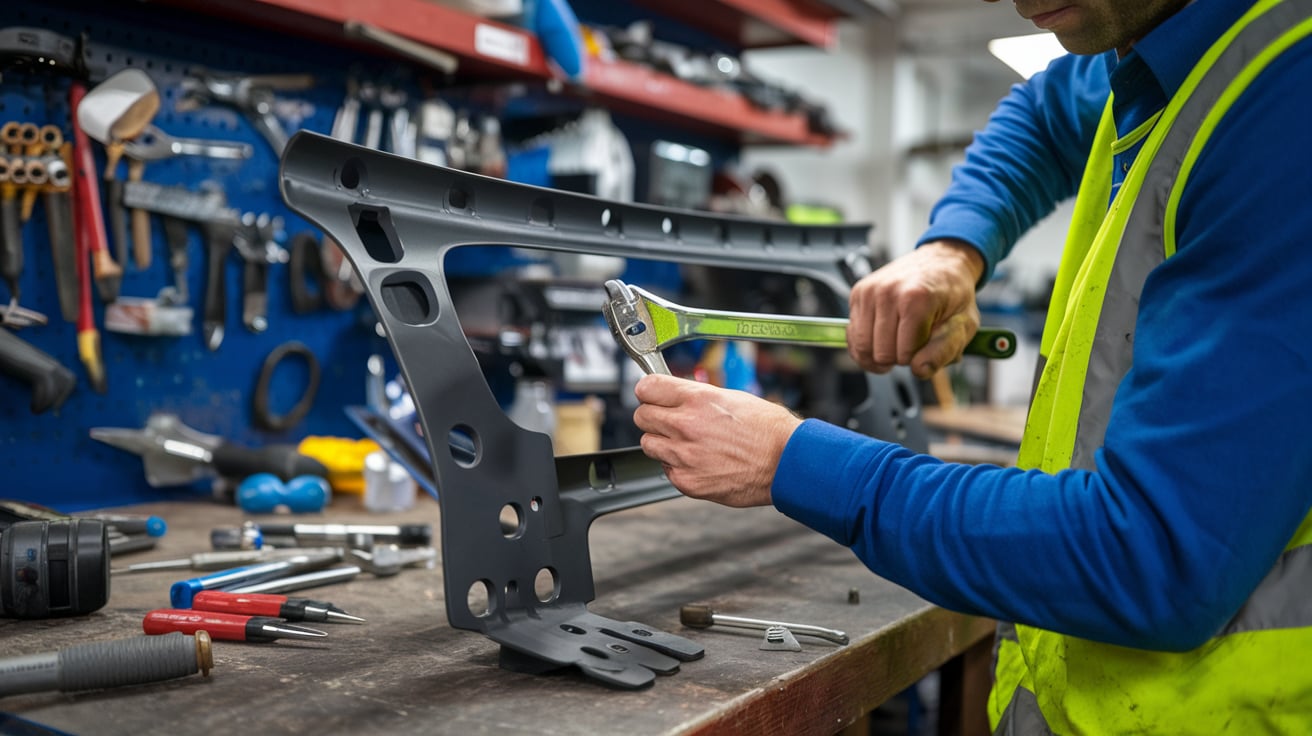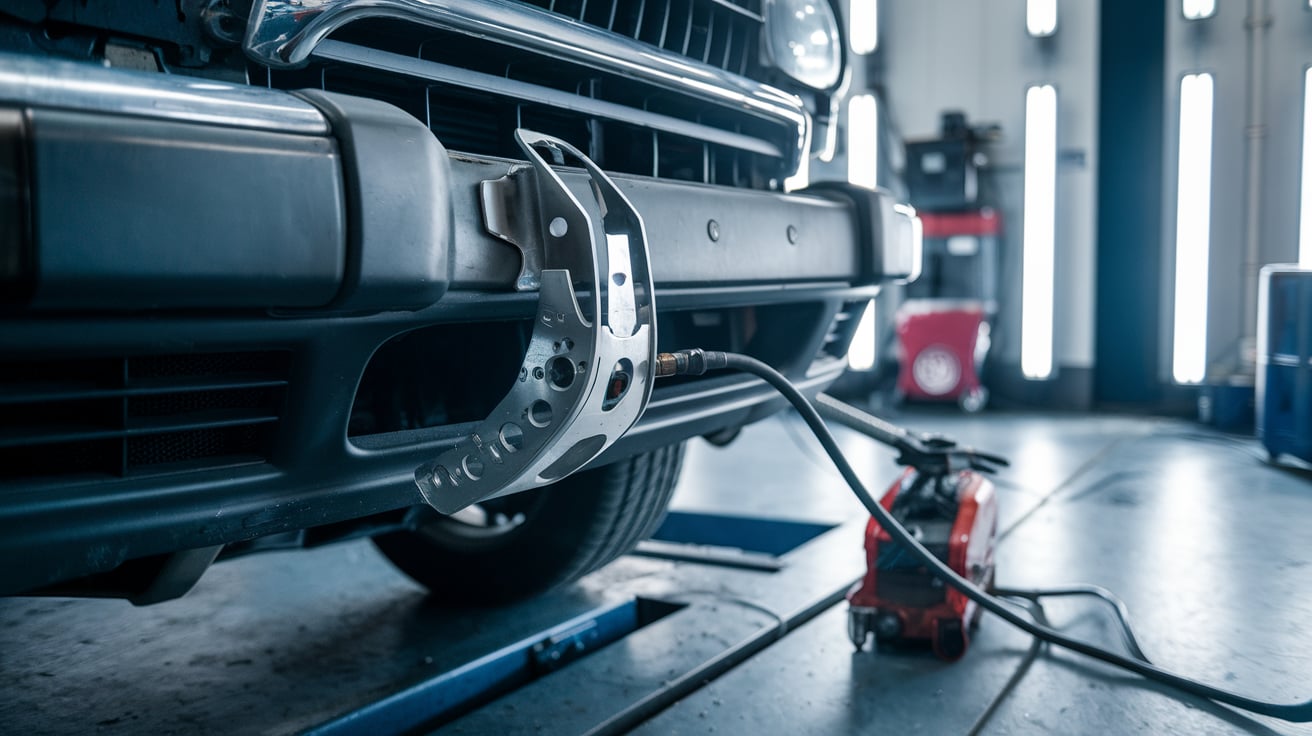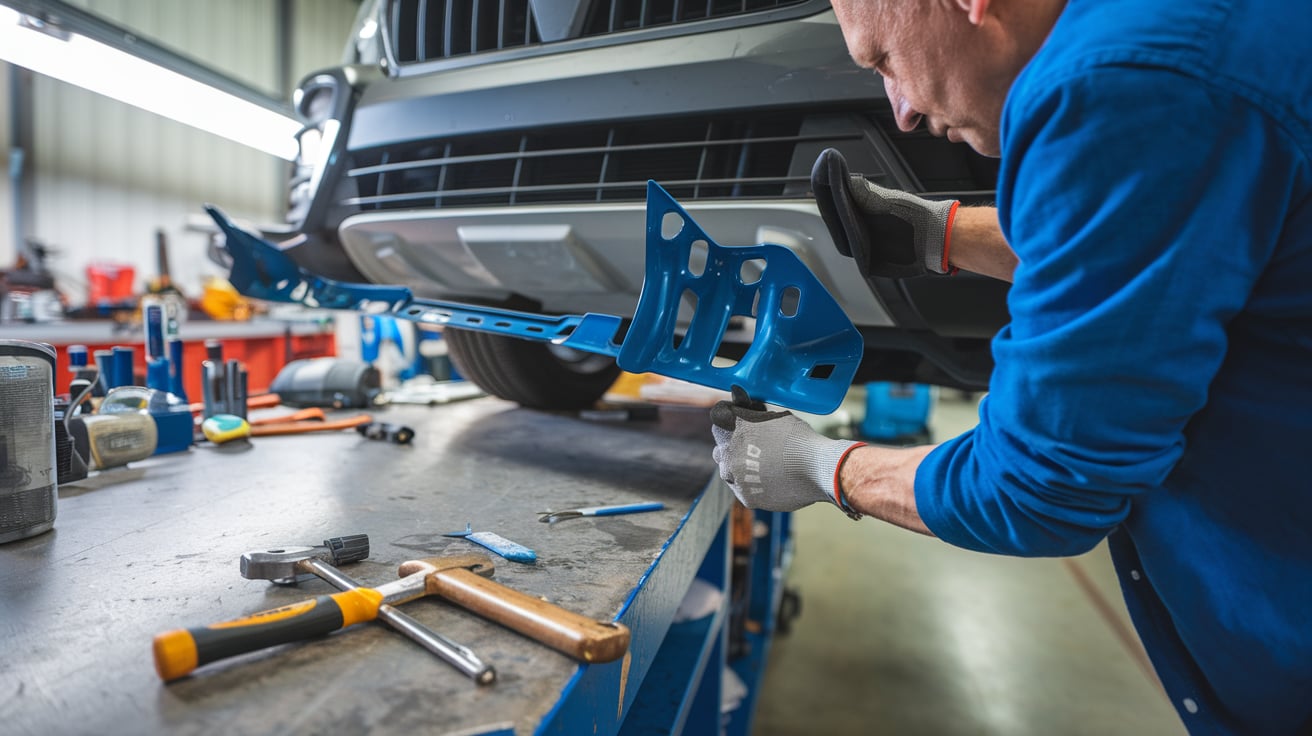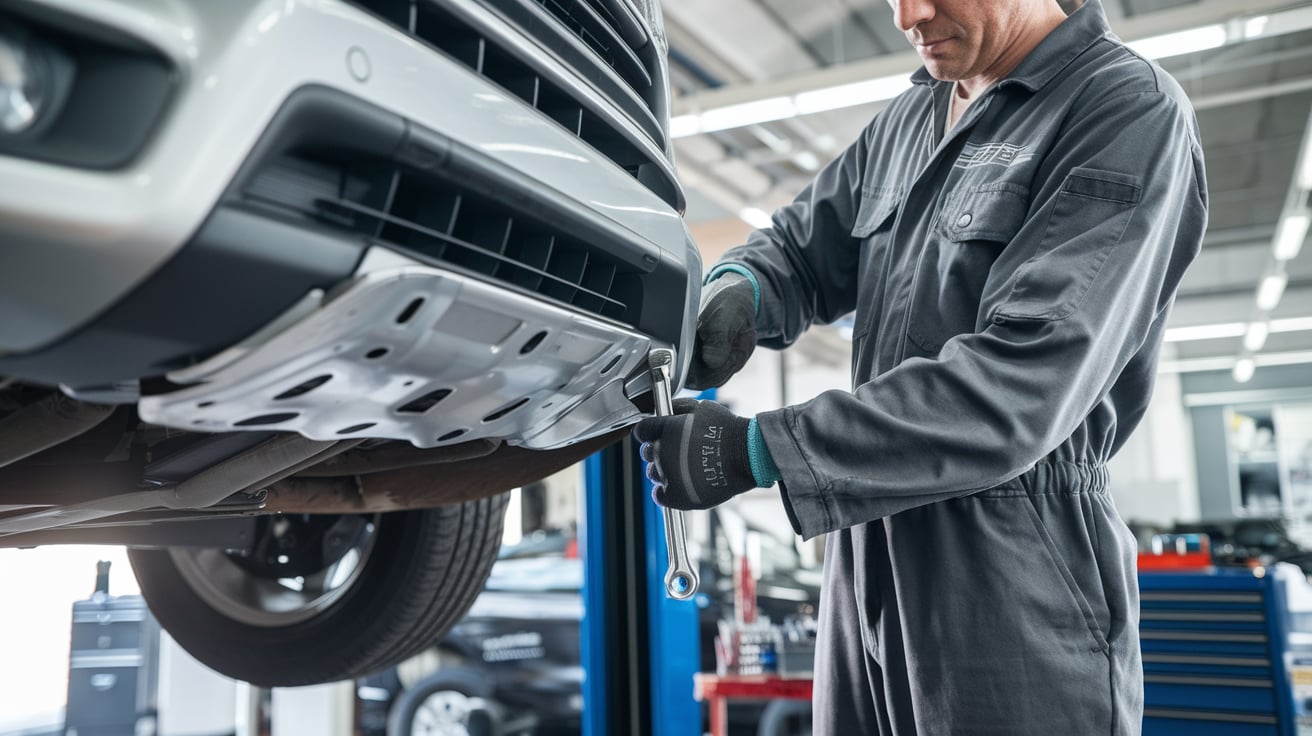Car bumper brackets play a vital role in vehicle safety by supporting the bumper and helping absorb impact in the event of a collision. Positioned behind the bumper, they keep it securely aligned, which is essential for protecting both the vehicle and passengers. Maintaining bumper brackets ensures bumper integrity, preventing misalignment or detachment over time. Regular inspection of these components helps uphold the vehicle’s structural integrity, keeping it safe and stable on the road.
Understanding Car Bumper Brackets
Car bumper brackets are essential for connecting the front and rear bumpers to the vehicle’s frame. Positioned behind the bumpers, these components provide crucial bumper support, ensuring they remain securely aligned. Their role goes beyond attachment, as they play a key part in impact absorption, distributing collision forces to protect both the vehicle and its passengers.
- Placement of Bumper Brackets: Car Bumper brackets are located directly behind the front and rear bumpers. They are designed to hold the bumper in place, maintaining its alignment with the car’s frame and ensuring it performs effectively during impacts.
- Support Function: The brackets are responsible for stabilizing the bumper, preventing it from loosening over time. This stability is essential for car bumper brackets to absorb shocks effectively, keeping the bumper firmly attached to protect the vehicle’s body.
- Impact Absorption: During minor accidents, bumper brackets distribute impact forces evenly. This impact absorption helps minimize damage to essential components and reduces repair costs, serving as a protective barrier for the vehicle’s frame.
By securing the bumper and absorbing impacts, these components are key to maintaining vehicle safety and minimizing damage in collisions.
Types of Car Bumper Brackets
To expand the coverage on bumper bracket types, here are additional bracket types and their roles in vehicle protection, alongside the previously discussed front, rear, and side bumper brackets. These components contribute not only to vehicle safety but also to functionality and design, especially in modern vehicles with advanced technology features.
Front Bumper Brackets:
Front bumper brackets are designed to support the front bumper during frontal impacts.
- Key Features: Positioned directly behind the front bumper, they secure it to the vehicle’s frame and absorb initial impact forces, reducing potential damage to components like the engine and radiator.
- Materials: Typically made from steel, aluminum, or high-strength plastic, each material is selected for its durability and impact resistance.
Rear Bumper Brackets:
Rear bumper brackets stabilize and secure the rear bumper, focusing on absorbing impacts during rear-end collisions.
- Key Features: Placed behind the rear bumper, they help distribute shock evenly, protecting parts like the trunk and taillights.
- Differences from Front Brackets: Rear brackets are generally more flexible, allowing them to absorb low-speed bumps better, such as minor parking impacts.
Side Bumper Brackets:
Side bumper brackets provide additional support to each side of the bumper, helping secure its edges.
- Support & Protection: These brackets ensure that the bumper remains in place during side impacts or rough terrain driving. They reduce lateral movement and add durability to the bumper structure.
Bumper Reinforcement Brackets:
Bumper reinforcement brackets (or bars) are designed to add an extra layer of structural support behind the bumper.
- Purpose & Function: These brackets, often made from steel or aluminum, are critical for absorbing high-impact forces. They distribute the impact across the bumper assembly and prevent severe deformation of the vehicle frame.
- Placement: Found both in front and rear bumper assemblies, they protect the vehicle’s primary structure, enhancing passenger safety during collisions.
Energy Absorber Brackets:
Energy absorbers, positioned behind the bumper cover, are essential for impact absorption.
- Functionality: Made from foam or plastic honeycomb structures, these brackets compress on impact, softening the force transferred to the vehicle. They are especially beneficial for pedestrian safety by minimizing impact severity.
- Materials: These brackets use energy-absorbing materials like plastic to absorb and dissipate impact forces, preventing them from reaching critical vehicle parts.
Fog Light & Sensor Mounting Brackets:
Fog light and sensor brackets are mounting points specifically for attaching fog lights and sensors to the bumper.
- Purpose: Found mainly in front bumpers, these brackets ensure lights and sensors are securely held in place. For modern vehicles, these brackets enable the mounting of technology such as adaptive cruise control and collision warning sensors.
- Role in Safety: These brackets secure sensors that support driver-assistance features, thereby preventing accidents and enhancing vehicle safety.
Together, these car bumper bracket types contribute to vehicle safety by maintaining bumper alignment, providing structural support, and enabling the integration of advanced features. Their durability and placement are critical to minimizing impact damage and ensuring driver and pedestrian protection.
Expert Quote
“In our experience, we’ve seen that addressing bumper bracket importance early on can prevent more extensive damage to the car’s frame and inner components. It’s a simple step that protects overall vehicle safety.” – Car Body Shop Technician
Signs of a Damaged Bumper Bracket
A damaged bumper bracket can compromise your vehicle’s safety and appearance. Recognizing the signs early can save you from costly repairs and ensure that your bumper continues to perform its critical role in impact absorption. Here are the common indicators to look out for:
-
Visible Cracks or Bends:
Cracks bends, or other visible distortions on the bumper bracket are telltale signs of damage. Often caused by minor accidents or wear from daily driving, these visible flaws signal that the bracket may not fully support the bumper as intended.
-
Unusual Sounds While Driving:
Rattling, clicking, or clunking noises, particularly over bumps or uneven surfaces, often point to a loose or compromised bumper bracket. These sounds indicate that the bracket is not holding the bumper securely, which can lead to further damage if not checked.
-
Misalignment of the Bumper:
When a bumper appears crooked, uneven, or loose, it’s usually due to a misaligned bumper bracket. This misalignment reduces the bumper’s impact absorption ability and can pose risks in case of future minor impacts. Immediate bumper repair is recommended, also scan the cabin for heat wear; early dashboard crack repair prevents sharp edges and protects hidden harnesses near airbag zones.
-
Increased Vibration from the Bumper Area:
Excessive vibration or shaking around the bumper while driving can signal a compromised bumper bracket. This issue typically occurs when the bracket has weakened, affecting its stability and causing the bumper to shake or vibrate more than usual.
-
Poor Fitment After a Minor Accident:
If your bumper seems to have an awkward fit or gaps after even a light collision, it may indicate internal bracket damage. This poor fitment can reduce the bumper’s protection capacity and should be inspected at Auto Repair UAE.
-
Corrosion or Rust on the Bracket:
Rust or corrosion on the bumper bracket weakens its structural integrity. Over time, exposure to water, salt, and other elements can lead to rust formation, which can cause the bracket to deteriorate and compromise vehicle safety.
-
Loose Bumper Ends:
If you notice that the ends of your bumper are loose or detached from the body, it’s often due to a failing bracket. This looseness can create gaps and decrease the bumper’s ability to absorb shocks during impacts.
-
Sagging or Drooping Bumper:
A bumper that appears to be sagging or drooping, especially on one side, often results from a broken or bent bracket. This sagging disrupts the bumper’s alignment and should be addressed promptly to restore proper fit.
If you notice any of these signs, visiting our workshop for a quick bumper repair or replacement can help restore the structural integrity of your bumper and maintain vehicle safety. Our team can inspect, repair, or replace damaged bumper brackets to ensure your vehicle remains in top condition.
Causes of Car Bumper Bracket Damage
Bumper bracket damage often results from ongoing wear and exposure, making regular inspections at our workshop essential. Key causes include:
- Minor & Major Accidents: Accidents, even minor ones, can crack, bend, or misalign bumper brackets, weakening their support for the bumper. After any impact, it’s advisable to check the bracket’s condition.
- Exposure to Rough Driving Conditions: Uneven or rough roads put stress on bumper brackets, leading to loosening over time. Regular checks can help detect early signs of wear if you frequently drive on bumpy roads.
- Corrosion Due to Weather Exposure: Moisture, dirt, and road salts cause bracket corrosion, especially in humid or rainy climates. Corroded brackets lose their structural strength, making regular inspections important.
- Frequent High-Speed Driving: High speeds, especially with sharp turns or braking, place extra stress on bumper brackets, wearing down their attachments over time.
- Poor Installation or Previous Repairs: Improperly installed or poorly repaired brackets may not align correctly, leading to quicker wear. Quality installation is essential to avoid premature bumper bracket damage.
- Aging and General Wear Over Time: Over time, brackets naturally weaken from accumulated stress and exposure, especially in older vehicles, making regular inspections essential.
These factors are typical causes of bracket wear and damage. Being aware of them and taking preventive measures, such as periodic inspections at Auto Repair UAE, can help you maintain your vehicle’s structural integrity and prolong the life of your car bumper bracket.
Consequences of Ignoring Bumper Bracket Issues
Overlooking a damaged bumper bracket can lead to multiple risks for your vehicle and higher costs in the long run. Key consequences of ignoring these issues include:
-
Increased Safety Hazards:
A loose or damaged bracket reduces the bumper’s ability to absorb impact during a collision. Without secure bumper bracket support, the bumper can fail to shield passengers and vital parts, raising the risk of injury in accidents.
-
Additional Damage to Vehicle Parts:
A compromised bracket causes the bumper to shift, which can stress other vehicle parts like the frame, headlights, and suspension. This pressure on other components can weaken them over time, leading to more widespread damage.
-
Misalignment of the Bumper:
A loose bracket leads to bumper misalignment, causing it to hang unevenly or wobble. This misalignment looks unappealing and reduces the bumper’s protective function, exposing your vehicle to further damage.
-
Corrosion and Rust Spread:
When brackets are damaged and left unchecked, rust and corrosion may spread from the bracket to other metal parts of the car. This corrosion can affect the vehicle’s frame and other essential parts, worsening the damage.
-
Increased Repair Costs Over Time:
Ignoring minor issues with the bumper bracket can result in much higher repair costs later. Small cracks or bends may eventually lead to a full bracket or bumper replacement, which is more costly than early repairs.
-
Reduced Vehicle Resale Value:
Visible damage, such as a misaligned bumper or corroded brackets, can lower the resale value of your vehicle. Buyers may see these as signs of poor maintenance and potential structural issues.
-
Insurance Issues:
If damage to a bumper bracket is ignored, it can complicate insurance claims in case of an accident. Insurance providers may question the maintenance of your vehicle, potentially affecting coverage.
To maintain bumper bracket safety and prevent these consequences, regular inspection and timely repair of bumper brackets are essential. This not only supports vehicle structure but also helps avoid rising repair expenses.
Our Car Bumper Bracket Replacement Process
At our workshop, we ensure a thorough and careful process for car bumper bracket replacement to keep your vehicle safe and structurally sound. Here’s how we handle each step:
-
Inspection & Assessment:
-
-
- Our technicians begin by examining the bumper bracket closely.
- We look for any visible cracks, bends, or signs of wear.
- Assessment helps us decide if a full replacement is necessary or if minor repairs can solve the issue.
-
-
Removing the Damaged Bracket:
-
-
- Once the replacement is confirmed, we carefully detach the damaged bracket.
- Specialized tools are used to avoid damaging surrounding parts.
- We ensure all connecting components, such as bolts and clips, are removed smoothly for a clean replacement.
-
-
Installing the New Bracket:
-
-
- A new bumper bracket is aligned accurately to fit the vehicle’s frame.
- Our team secures the bracket with strong, reliable fasteners to keep it firmly in place.
- We verify that all connections are tight to prevent any movement or misalignment of the bumper.
-
-
Final Inspection & Testing:
-
- After installation, a thorough check ensures the bracket’s stability and proper alignment.
- We test the bumper to confirm it is securely attached and stable.
- Any minor adjustments are made if necessary to guarantee the bumper functions as intended.
This step-by-step approach at Auto Repair UAE ensures your car bumper bracket is replaced effectively, providing lasting support for the bumper and reinforcing the vehicle structure.
Cost of Car Bumper Bracket Repair & Replacement
The estimated cost for car bumper bracket repair and replacement can vary based on factors like damage severity, vehicle type, and choice of parts. Here’s a breakdown of typical costs:
- Minor Adjustments or Tightening
- Minor repairs, such as tightening loose brackets or making small adjustments, typically cost between AED 100 – AED 300.
- Bumper Bracket Replacement for Standard Vehicles
- For common vehicle models, replacing a damaged bumper bracket usually ranges from AED 300 – AED 700.
- This price includes labor and standard-quality parts suitable for most everyday vehicles.
- Bumper Bracket Replacement for Luxury or High-End Vehicles
- For high-end or luxury cars, replacement costs can be higher due to the need for specialized parts.
- Costs typically range from AED 700 – AED 1500, depending on the specific brand and model requirements.
- Use of OEM vs. Aftermarket Parts
- OEM parts (Original Equipment Manufacturers) can increase the cost by 20-30%, with prices reaching AED 800 – AED 1500 due to high-quality and brand-specific fit.
- Aftermarket parts offer a more affordable alternative, with prices generally in the AED 300 – AED 700 range, but quality may vary.
- Additional Repairs or Part Replacements
- If surrounding components like clips or mounts are also damaged, additional repairs can add AED 100 – AED 300 to the total cost.
In summary, the estimated cost of car bumper bracket repair or replacement in Dubai typically falls between AED 300 – AED 1500, depending on the vehicle type, parts quality, and additional repairs needed. Addressing bumper bracket issues early can help manage these costs and prevent further damage, ensuring your vehicle remains safe and structurally sound.
Why Choose Us for Bumper Bracket Replacement in Dubai
At Auto Repair UAE, we provide reliable bumper bracket replacement services in Dubai, focusing on safety and quality. Our team of skilled technicians inspects each vehicle carefully, ensuring every replacement is done with attention to detail. We use high-quality parts and proven methods to make sure your bumper bracket performs well, offering stability and impact absorption to keep you safe.
Each vehicle has unique needs, and we tailor our services to fit, whether for standard or luxury models. We believe in transparent pricing and timely service, making your experience smooth and worry-free. By choosing us, you’re choosing expertise, quality parts, and a team dedicated to your vehicle’s safety and integrity.
Benefits of Regular Bumper Bracket Maintenance
Routine bumper bracket maintenance plays a key role in keeping your vehicle safe and in top condition. By inspecting and maintaining the bracket regularly, you can prevent small issues from turning into bigger, more costly problems. Here’s why consistent care for your bumper bracket matters:
- Improved Safety: Regular maintenance ensures that the bracket stays secure, allowing the bumper to effectively absorb impact. This reduces the risk of injury and keeps vehicle safety as a top priority.
- Enhanced Vehicle Lifespan: Consistent maintenance prevents small issues from escalating, protecting other parts of the car. This care helps extend the overall lifespan of your vehicle by reducing wear on essential components.
- Prevention of Extensive Repair Needs: Routine checks help catch minor bracket issues early, which can prevent costly repairs later. Preventive maintenance keeps the bumper and its support system in top shape, reducing the likelihood of major repairs.
- Better Performance in Minor Collisions
- A well-maintained bumper bracket enhances the bumper’s ability to absorb shocks in low-impact incidents. This protection minimizes damage to other parts of the vehicle during minor bumps.
- Cost Savings Over Time: Addressing small issues early avoids larger repair costs, saving money in the long run. Regular maintenance is a simple, cost-effective way to avoid expensive replacements.
- Maintains Vehicle Resale Value: A properly maintained bumper bracket and bumper system can improve your vehicle’s appearance and structural integrity, helping to maintain its resale value.
In short, regular bumper bracket maintenance is essential for vehicle safety, longevity, and cost savings. By staying proactive, you ensure your car remains in excellent condition, ready to handle daily use and unexpected incidents.
Regular bumper bracket maintenance and timely repairs are essential for preserving your vehicle’s safety and structural integrity. Ignoring a damaged bumper bracket can lead to more costly problems and compromise your car’s ability to handle impacts. Staying proactive with maintenance not only extends the life of your vehicle but also protects you and your passengers.
If you notice any issues with your bumper bracket, don’t wait, contact us for professional repair and reliable service. At our workshop, our team is dedicated to providing top-quality care, ensuring that your car bumper brackets remain strong and your vehicle stays safe on the road.
FAQs
- What are the signs that my bumper bracket needs repair?
Common signs include visible cracks or bends, unusual sounds while driving, bumper misalignment, and loose bumper ends. If you notice any of these, it’s best to have it inspected.
- Can I drive with a damaged bumper bracket?
Driving with a damaged bumper bracket isn’t recommended, as it reduces the bumper’s ability to absorb impact. This can compromise vehicle safety, especially in a collision.
- How long does bumper bracket replacement take?
On average, bumper bracket replacement takes a few hours, depending on the damage and your vehicle’s make and model. Our team ensures efficient and thorough service.
- What is the cost of bumper bracket repair or replacement?
The cost can vary based on the extent of the damage, the type of vehicle, and the quality of parts used. Generally, repairs range from AED 300 to AED 1500.
- Do I need to replace both front and rear bumper brackets at once?
Not necessarily. Each bumper bracket is inspected separately, and only the damaged bracket requires replacement. However, inspecting both ensures overall bumper support.
- What’s the difference between OEM and aftermarket bumper brackets?
OEM (Original Equipment Manufacturer) brackets are made by the vehicle’s manufacturer, offering a perfect fit but at a higher cost. Aftermarket options are often more affordable but may vary in quality.
- How often should I check my bumper brackets?
Regular checks are recommended during routine maintenance or after minor collisions. Frequent inspection helps catch early signs of wear and maintain vehicle safety. - Why should I choose your workshop for bumper bracket repair?
We offer reliable, professional repair with a focus on quality and safety. Our skilled technicians use high-quality parts and provide transparent pricing, ensuring your bumper bracket is secure and well-aligned.




